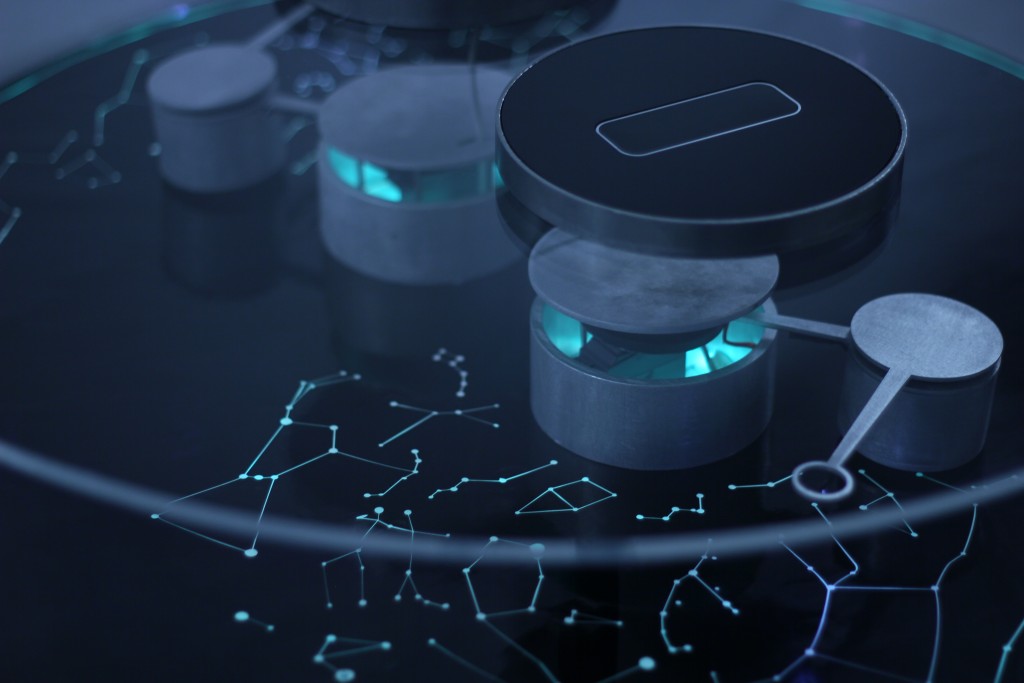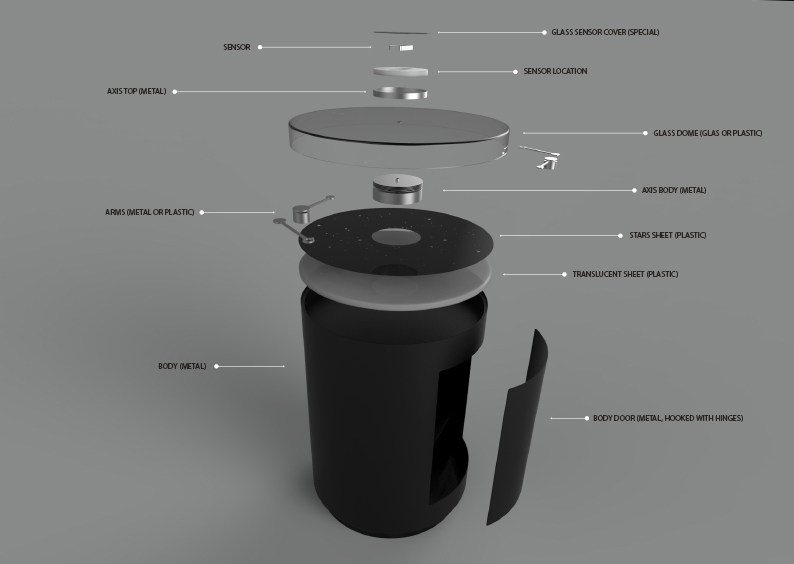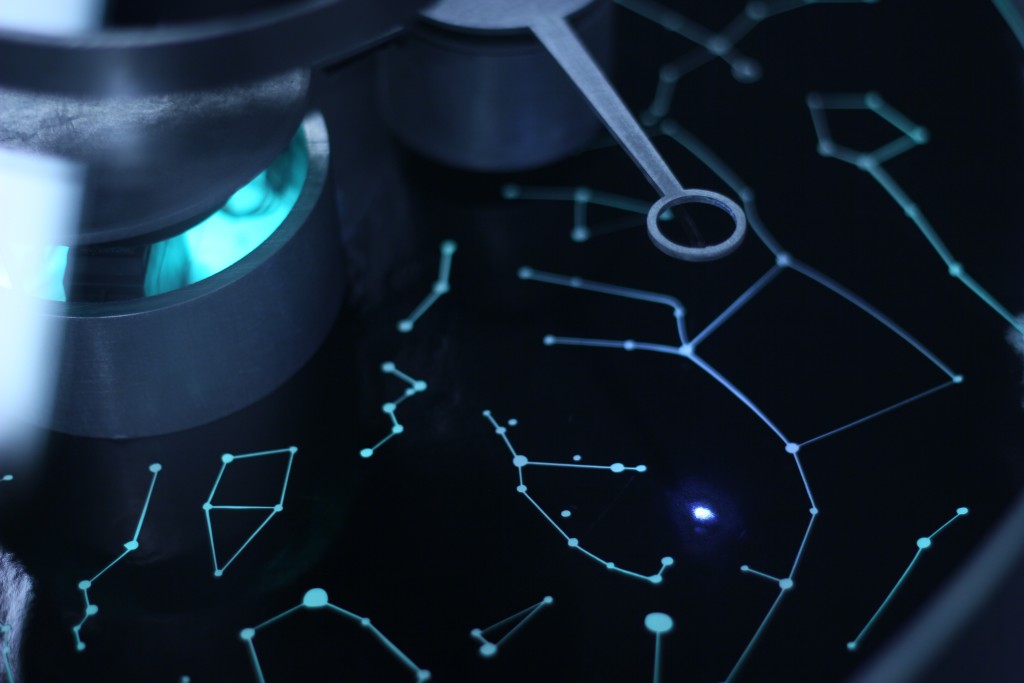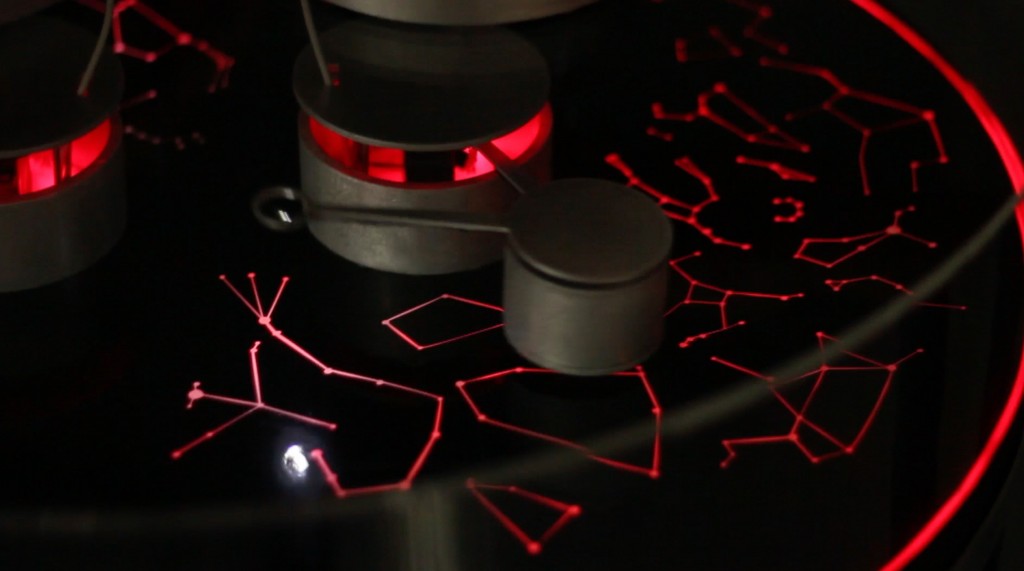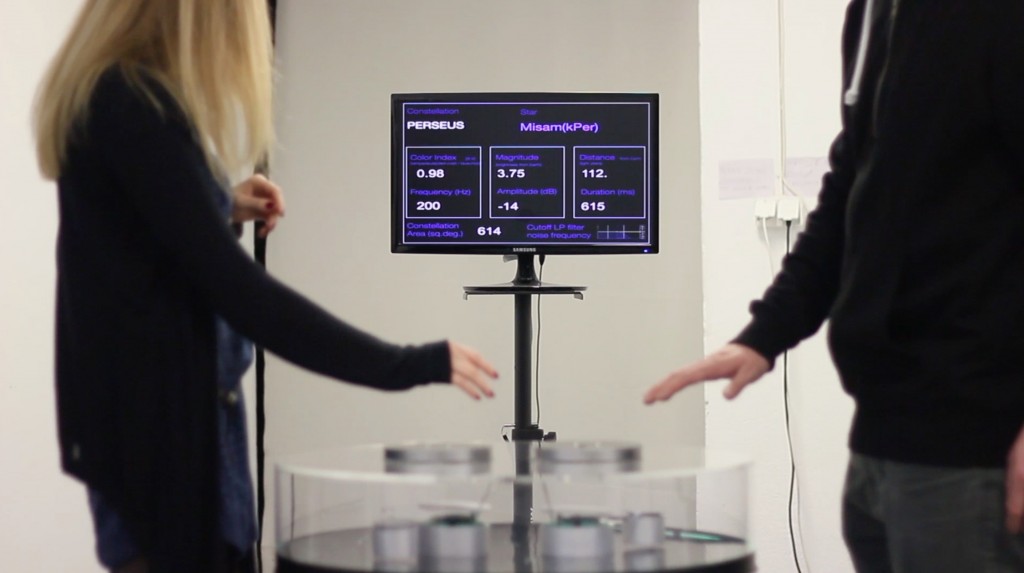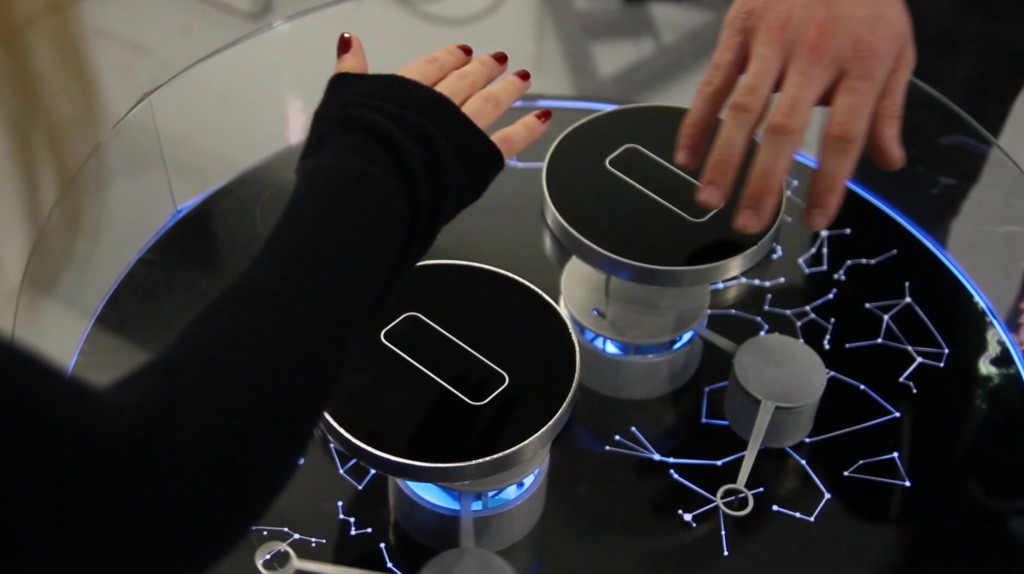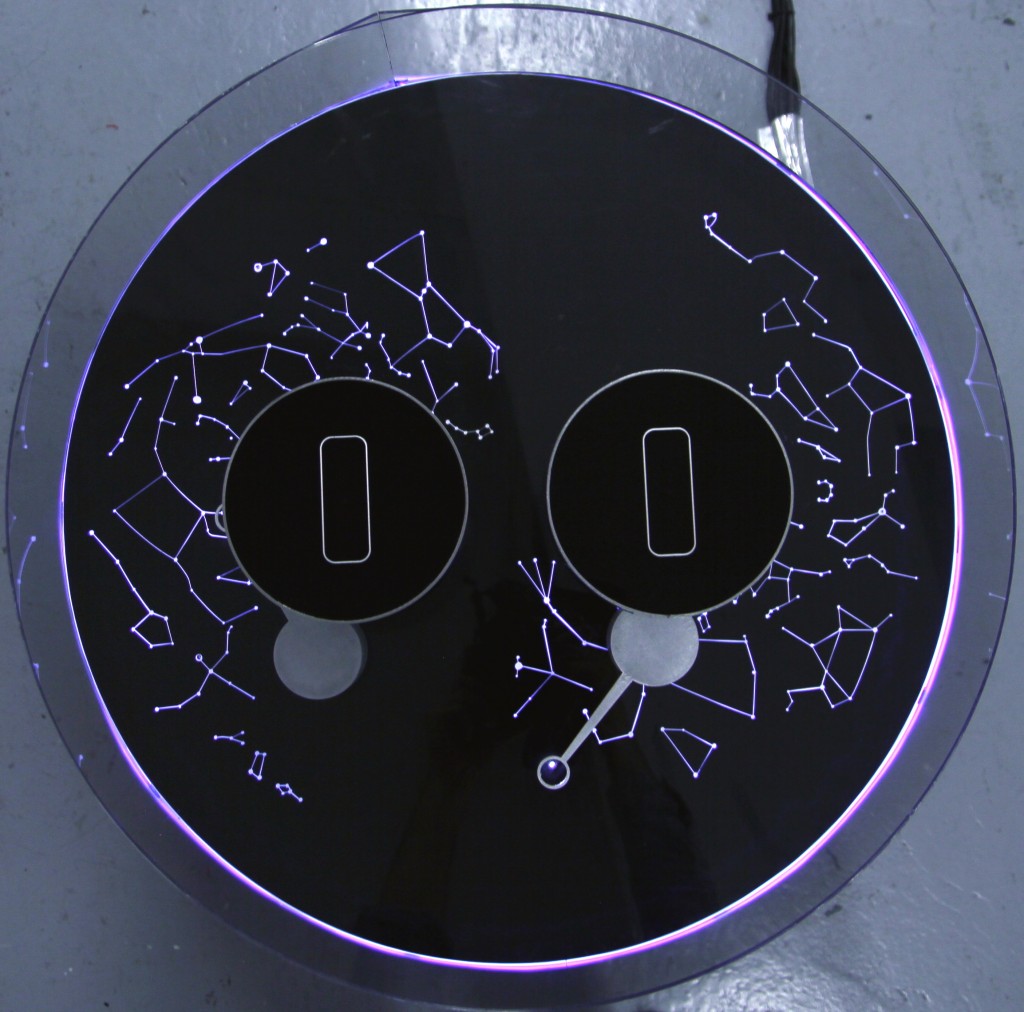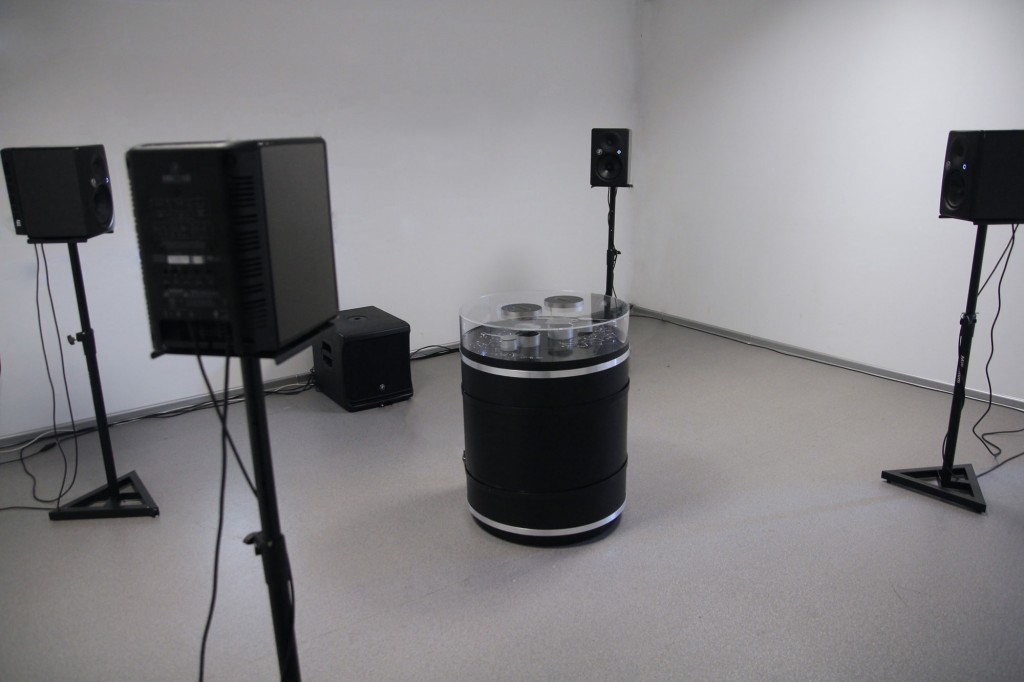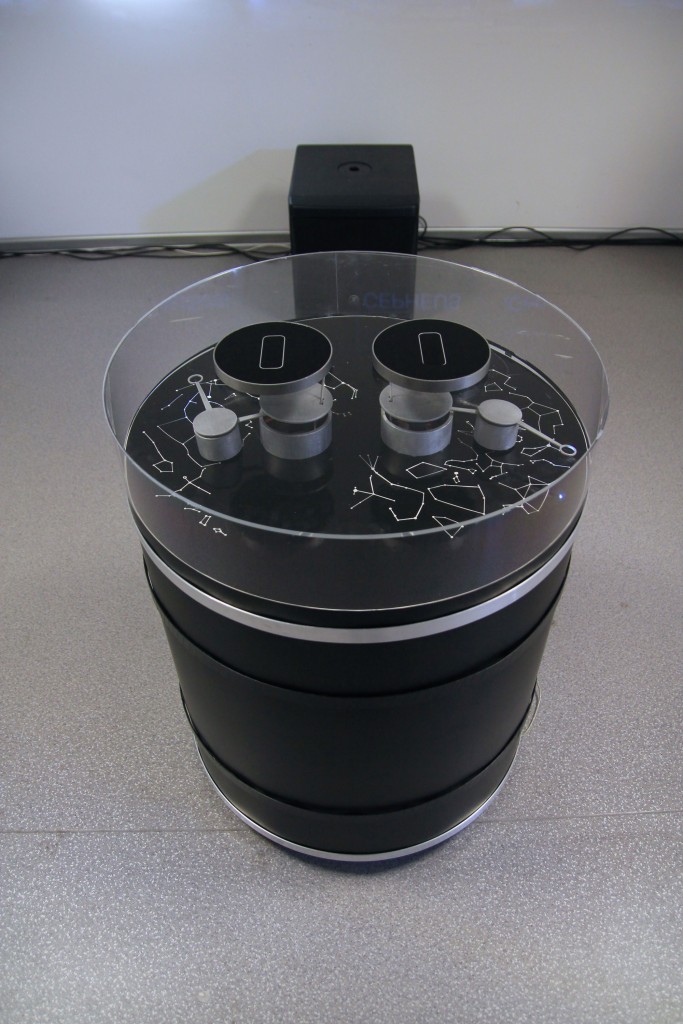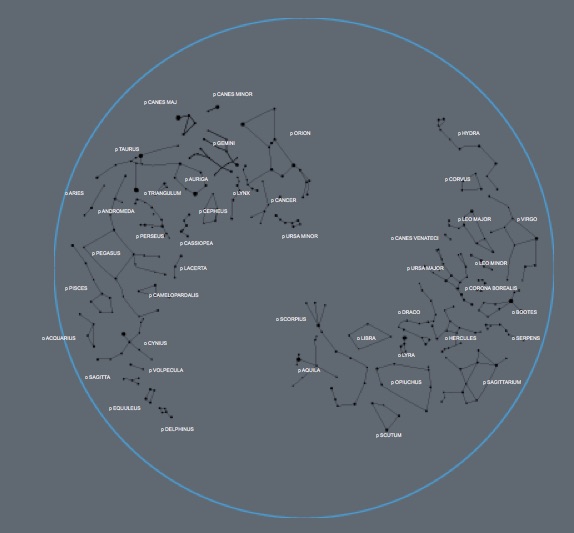Stellar
installation
DESCRIPTION
Stellar is an interactive installation and interface for scientific data sonification.
The project aims to create a sonic representation of stars and constellations through a dedicated interface.
Since there is no sound in space, the objective was to conceptualize a link between electromagnetic and sound waves. The goal was to create a minimalist, interactive device that would allow visitors to learn about specific stars through sound information.
The base of the system is a cylindrical structure, on top of which the most important constellations of the northern sky are displayed. Above this representation are two robotic arms. Two players can use the system simultaneously by moving their right hands over the two black, circular sensors. This allows them to move the robotic arms both horizontally and vertically. When the tip of one of the arms aligns with a star, the information obtained from it is translated into sound materials. The same concept is applied visually. When a star is selected, the circular viewpoint depicting the stars will light up in the actual color of the star. These colors are also projected onto the walls. Visitors can see the information about the stars and their sonification in real time through one or two monitors placed next to the structure. Sound spatialization is provided with a quadraphonic system.
The project has been developed using Arduino and Max7 software. Data of more than 300 stars from all 44 constellations of the northern hemisphere has been sourced from the open-source software Stellarium.org and coded to interact with the robotic arms.

STELLAR 1.0
In the first version of Stellar, a minimal and elementary approach was chosen, perhaps at the expense of a more captivating sound performance, but in favor of greater clarity and conceptual coherence. For this reason, only sinusoidal sounds were used. The sound engines are, in fact, two simple polyphonic synthesizers.
The data detected for each star are: temperature (color index: red star = old and cold, blue star = hot and young), brightness (as seen from Earth), and distance (from Earth); respectively transformed into: frequency (Hz), amplitude (dB), and duration (ms).
The colder the star, the lower the pitch; the brighter it appears to us from Earth, the louder the sound; the further from Earth, the longer the duration. For example, a bright, red star thousands of light years from Earth would generate a low frequency, loud, and long sound. A blue star that is closer to Earth would generate a high frequency, weaker, and shorter sound.
The background drone sound is white noise (which is a combination of all frequencies, the opposite of space-silence). When a constellation is triggered, the number representing its area (square degrees) becomes the cutoff frequency of a low-pass filter for the noise signal. In this way, larger constellations will gradually increase the noise spectrum.
STELLAR 2.0
The second version of Stellar includes a wider range of audio and visual solutions. The first addition is two new synthesis engines that allow the creation of more complex sounds, favoring a more creative use of the interface.
The first new synthesizer is a granulator. The decision to use this type of synthesis is not random, but linked to the path that led to its theory. Granular synthesis derives from considering sound to have the same nature as light, which connects well to the sonification process that occurs in Stellar. For this synthesizer, a type of granular synthesis called prototype asynchronous has been utilized, which uses source material waveforms without preserving the timbre. The granulator parameters are: frequency, length of grains, grain density, number of harmonics, and inharmonicity. In the granulator, a distortion, a simple delay with feedback, and an automated stereo pan-pot have also been implemented. The temperature of the stars is mapped to the frequency, the magnitude to the density of the grains, and the distance from Earth to the length of the grains.
In Stellar 2.0, a new type of data sonification has been used with APIs made available by the darksky.net site. With an internet connection, it was possible to obtain real-time information about the weather conditions of a specific place. The data considered include outdoor temperature, cloudiness, wind speed, and the amount of precipitation.
The outdoor temperature controls the number of harmonics: the higher the temperature, the warmer the sounds. It was conceptually coherent to correlate cloudiness with the stellar quality of observation, using it to control sound distortion. Another potentially disturbing factor is wind speed, which is mapped to the inharmonicity of the granulator. In this way, with calm conditions, harmonic sounds will be produced, whereas with worse scenarios, the dissonant amount will gradually increase. Finally, the amount of precipitation controls the frequency of the stereo pan pot.
The concept for the third and final synthesis engine is cosmic chaos. An additive synthesis synthesizer with a random system constantly changes the assignment of the mapping of the sonified parameters. In addition to the sound synthesis, a visual component was developed using a patch written in Jitter. This made it possible to create abstract patterns controlled by real-time sound content and characterized by the actual colors of the triggered stars.
To control all functions, a touchscreen interface was designed using “Lemur” on an iPad. The screen displays a mixer through which it is possible to mix the sounds generated by the different synthesis engines.
PRODUCED AND SUPPORTED BY
DE.MO./MOVIN’UP I Session 2015 project, and promoted by the Ministry of Cultural Heritage & Activities & Tourism, General Directorate for Contemporary Art, Architecture and Urban Suburbs and GAI – Association for the Circuit of the Young Italian Artists.
MEDIUM
Motion sensors, microprocessors, generative software algorithms, servo motors, multichannel speakers, projectors, plexiglass, wood, aluminium, leds, networking
EXPOSITIONS
15-22 November 2015 – Première at Audio Art Festival 2015 c/o Galeria Bunkier Sztuki, Krakow, Poland
26 November 2015 – Poster at IRCAM Forum Workshop 2015 c/o Pompidou Center, Paris, France
13 April 2016 – Milan Design Week c/o Comehome Fuoribalcone, Milan, Italy
1 July 2016 – Chiostro di Note, Castelfranco Veneto, Italy
18-21 May 2017 – Athens Digital Arts Festival, Athens, Greek
24-29 October 2017 – PatchLab Digital Art Festival, Krakow, Poland
PRESS
The Creators Project, Arduino.com Homepage, s+v+m, InteractiveDesign.it, Popaganda, Adafruit,Atmel, Codeduino, Planet Arduino, dA.
TEAM
Francesco Fabris: concept, direction, programming
Patrycja Maksylewicz: 2D design
Przemysław Koleszka: manufacturing
Eloy Diez Polo: 3D prototype design
Thanks to: Marek Chołoniewski, Dominika Miłek, Agnieszka Jakubiak, Agnieszka Orzińska, Arshile Egoyan, Intermedia Art Department of Krakow




